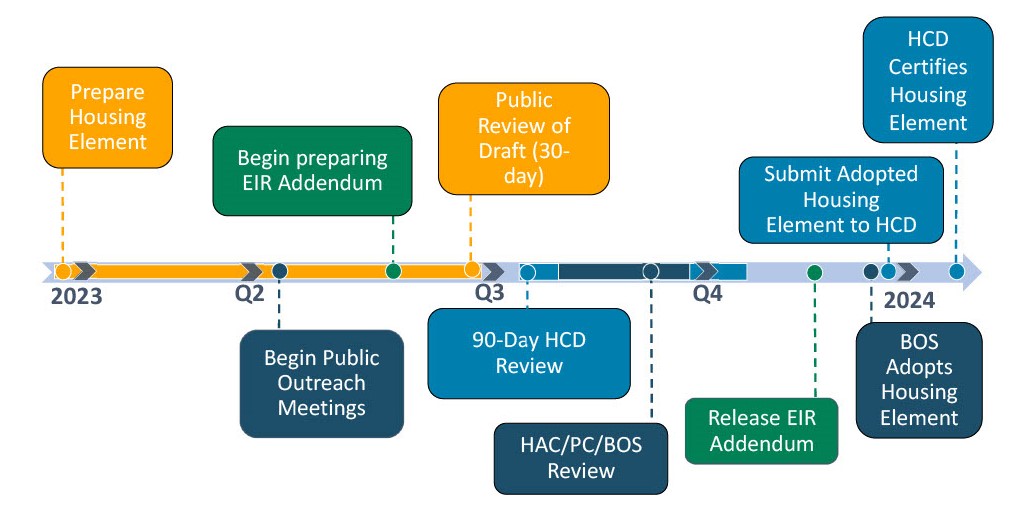What is the Housing Element?
The Housing Element is one of the 10 State-mandated “elements” or chapters of a local jurisdiction’s General Plan. It identifies policies and programs to meet existing and projected housing needs for all segments of the community, including various household types, special needs populations, and all income levels of the jurisdiction.
Regional Housing Needs Assessment (RHNA)
The Regional Housing Needs Assessment (RHNA) is mandated by State Housing Law as part of the periodic process of updating local Housing Elements. The California Department of Housing and Community Development (HCD) projects population growth by geographic region and designates the regional Councils of Government (COGs) as the agencies responsible for determining how the potential growth is to be allocated among the jurisdictions within the regions. The COG relevant to the County of Santa Cruz is the Association of Monterey Bay Area Governments (AMBAG).
The 2015 Housing Element (effective 2015 to 2023, also known as the 5th Cycle Housing Element) is currently in effect and will be replaced by the 2023 Housing Element (effective 2023 to 2031, also known as the 6th Cycle Housing Element).
For the 6th Cycle, the County of Santa Cruz has been allocated 4,634 housing units at specific affordability levels to accommodate the County’s projected housing needs. This allocation is the County’s RHNA. The Housing Element must identify “adequate sites” to accommodate this estimated growth. The County is also required to provide the programs, policies, and appropriate zoning to incentivize this growth.
It is important to note that, while the County may assist with the development of affordable housing through various programs and funding sources, it is not the direct role of the County to construct housing. Rather, the County is responsible for ensuring that adequate opportunities exist for housing development through zoning and by removing regulatory impediments to housing production. The table below shows the existing and newly prescribed RHNA allocation the County is responsible to plan for.
| Income Level |
5th Cycle RHNA |
6th Cycle RHNA |
Percent Increase |
| Very Low |
317 |
1,492 |
471% |
| Low |
207 |
976 |
471% |
| Moderate |
240 |
586 |
244% |
| Above Moderate |
550 |
1,580 |
287% |
| Total RHNA |
1,314 |
4,634 |
353% |
Affirmatively Furthering Fair Housing
Affirmatively Furthering Fair Housing (AFFH) is a set of federal and state laws which require jurisdictions to combat housing discrimination, eliminate racial bias, undo historic patterns of segregation, and lift barriers that restrict access to foster inclusive communities, achieve racial equity, and guarantee fair housing choice. The 6th Cycle Housing Element Update is required by AFFH to, (1) study whether the County meets these AFFH principles, and (2) facilitate deliberate action to explicitly address, combat, and relieve disparities resulting from past patterns of segregation to foster more inclusive communities.
Housing Needs Assessment and Inventory
When updating the Housing Element, jurisdictions are required to analyze housing needs, conditions and trends in the community, and then ensure that those needs can be met. The housing units allocated within the RHNA provide number of units at all income levels that must be accommodated. The Element must also show how special needs populations are accommodated.
The existing 2015 Housing Element Appendix includes a countywide inventory of properties that identifies approximately 787 vacant single-family sites, 110 underutilized single-family sites, 13 vacant multiple-family sites, 113 underutilized multi-family sites, 24 vacant commercial sites for potential mixed-use, and 252 underutilized commercial mixed-use sites (1,300 sites). Both urban and rural properties are included in the inventory, although capacity for additional units is focused within the Urban Services Line (USL). The 2023 Housing Element update must review all these sites to determine which have been developed and to what extent (e.g., are some lots still vacant or underutilized?), which sites should be removed from the list because they are built out, or which sites should be re-evaluated for their potential for additional units. Other sites will also be reviewed to determine if they should be included in the updated Housing Site Inventory.
Housing Element Update Process
The 2023 Housing Element Update is currently in progress. The element will be updated with new information, goals, policies, and programs to address the requirements described above. The Update will also include rezoning of specific properties to meet the 6th Cycle RHNA and AFFH/AFH requirements, review of potential environmental impacts, and a robust public participation process to ensure well-rounded and equitable community involvement.
The County anticipates a draft will be available for review by Summer 2023. After public review, the Draft Housing Element will be submitted to HCD for review and returned to the County with comments. Once the County has updated the document, the final Housing Element will be presented to the Board of Supervisors for adoption before final submittal to HCD in November 2023.
Project Timeline

| EIR |
Environmental Impact Report |
| HAC |
Housing Advisory Commission |
| PC |
Planning Commission |
| BOS |
Board of Supervisors |
| HCD |
California Department of Housing and Community Development |
Additional Resources
Explore the resources below to learn more about the Housing Element and update process: